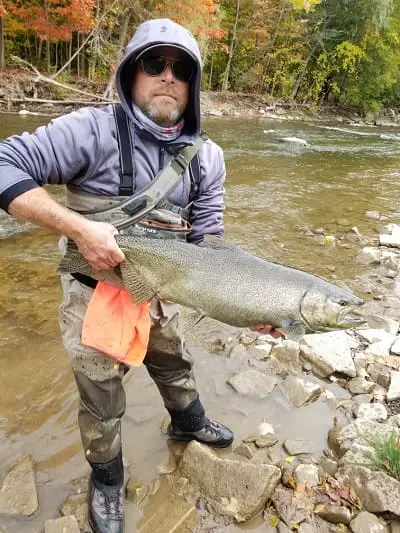Timing The Salmon Runs: What Triggers Them To Run?
There are times when tens of thousands of salmon will enter the rivers and the fishing can be fantastic. Then, a few days later, the same area can be void of salmon.
The salmon runs are triggered by many factors, and if you can predict the runs and be there when the salmon are there, your chances of catching lots of salmon are much better.

I call this “timing the runs,” and I and all my buddies do this to help us be on the water or in the right spots at the right times.
The salmon runs can occur from May until November, but the time they run is dependent on the area. Some salmon that run in Alaska in late May won’t run up rivers in the Great Lakes until late September.
The species of salmon also makes a difference since some salmon will run up the rivers earlier than others.
GUIDE TIP: You can often go to a salmon river guides website and they will tell you on the website when they guide for salmon so you know when to book your trip. Often, the time they list on their website for salmon is prime time fishing in that area, however, that doesn’t mean that some salmon won’t run weeks earlier or later.
I have seen this on the websites for salmon and steelhead fishing lodges too.
Oftentimes, water temperatures, rains, and even wind directions will trigger the salmon runs, especially on smaller rivers and streams. On larger rivers, the salmon can run at any time, and predicting their runs can be more difficult.
Rains Trigger Salmon Runs
As I became more experienced, I learned to predict the runs of salmon, and I learned how to do this for many of my local rivers. Leaning this was a game changer and it now means a lot more fish for my clients and me. This is something I wish I knew early on when I was learning how to catch salmon in a river.
Although the time of year, meaning fall is a trigger for salmon to spawn, on many rivers, one of the biggest triggers for the salmon to run is water flows in the river.
Big rains will increase water flows in the smaller rivers and the heavier flows will flow further out into the lake or ocean, and as schools of stagging salmon swim through these flows they will turn and head up the river.
The higher the water in the river, the further the flow will go out into the lake, and the further the current goes the more salmon will find that flow and go up the river. Big rains often mean big runs!
Salmon fishing a day or two after a big rain, or once the river clears, can be a hot time to be on the river.
The increased flows also offer the salmon a sense of security and make it easier for them to get through shallow sections of the river and over obstructions like dams and falls, and rapids. Higher flows can also make the salmon less weary and bite more.
The downside to increased water flows after huge rains are that the rivers can get muddy and the salmon can’t see your baits, and the salmon can spread out and be less concentrated which makes them harder to catch.
If the water is muddy, the day it clears to 14 to 18 inches of visibility can be fantastic fishing.
Another downside is angler safety. You may find it harder to wade the river or fish from the banks with higher flows.
Temperatures Trigger Salmon Runs
On some rivers that already have large flows even without the extra rainwater, once the river temperatures hit the desired temperature of the salmon, the salmon can run up the rivers based on just the temperature alone.
On many rivers that I fish, the temperature that starts the salmon runs in the fall is between 55 and 60 Fahrenheit or 12.7c to 15.5 Celsius and this is when the salmon fishing starts to get good.
Wind Can Trigger Salmon Runs
Another factor that can trigger salmon runs is the wind. This is something that many anglers don’t know about but should be a part of learning how to catch salmon in rivers.
Even without rain or without relying on water temperatures, winds can trigger the salmon to run.
There are times when strong winds blowing into shore can push staging salmon closer to the river mouth where they will swim through the current from the river that is flowing out into the lake or ocean. When they find that current it can trigger or signal them to run up the river.
Anglers that know this can capitalize on these hard-to-predict runs and they can experience some great salmon fishing.
The wind is more of a factor when the salmon are already staging closer to the shoreline and near the river mouths, or when they are roaming and looking for their preferred river.
I say preferred river because it’s common for most salmon to want to find and return to the same river they were born in
Graham
